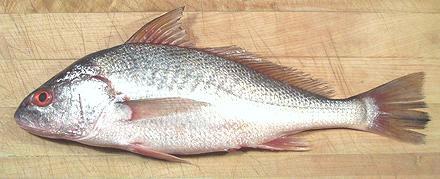 [Sea Bass; Micropogonias undulatus | very similar:
Spotfin Croaker Roncador stearnsi; | very similar:
Yellowfin Croaker Umbrina roncador; | very similar:
Sharpnose Hammer Croaker: Johnius borneensis]
[Sea Bass; Micropogonias undulatus | very similar:
Spotfin Croaker Roncador stearnsi; | very similar:
Yellowfin Croaker Umbrina roncador; | very similar:
Sharpnose Hammer Croaker: Johnius borneensis]
Asian markets here in Los Angeles often call this fish "Yellow Croaker", but Fishbase doesn't allow that name, reserving it for what the fish markets here usually call Corvina. I have noticed, though, a trend to call it "Atlantic Croaker". In parts of southeastern United States, this fish is called Corvina.
This fish is native to the West Atlantic, From Massachusetts down to southern Argentina, but skips Florida and parts of the Gulf of Mexico and Caribbean. It is considered a very good eating fish. This fish can grow to 22 inches and 5 pounds 11 ounces, but the photo specimen was 14 inches long and weighing 1 pound 3/4 oz. This fish is currently caught wild, with farming still in the experimental stages. It is not considered threatened.
More on Croakers and Drums.
This is a very good eating fish. The flesh is off white with a good medium flavor. Use simple sauces that won't mask the flavor and just lightly dust with rice flour for frying.
Buying: Here in Southern California these fish are found in Asian markets as "Yellow Croaker" (even though they are not yellow). They are a moderately priced fish, sometimes as low as 2011 US $1.99/pound, This fish is probably more widely marketed on the East and Gulf Coasts, and are probably just called "Croaker".
Scales: This Croaker is covered with medium size scales with medium adhesion. They fly about a bit when scraped off but not real badly.
Cleaning: No particular problems here. The gills are a bit prickly but can be pulled without tools.
Fillet: This fish is fairly easy to fillet. When you get to the ribcage, cut the ribs away from the backbone and pull them from the fillet with long nose pliers. They pull quite easily but in small fish they tend to break.
Yield: A 1 pound 3/4 ounce fish yielded 7-1/4 ounces of skin-on fillets (43%). Skin off 6.53 ounces (39%). This is a modest yield because the fillets are fairly thin.
Skin: Skin shrink is severe and does not relax. You'll need to skin fillets for frying or poaching. It is an easy fish to skin by the usual long knife and cutting board Method.
Cooking: Skinned fillets are excellent for pan frying and also for poaching. It's not a good candidate for frying whole because the head is wide compared to the body, and because of severe skin shrink. It does not work well as chunks in soup because the flesh is too tender and crumbles apart.
Moderate sized fish can be baked or steamed whole or pan dressed if a few diagonal slashes are made through the skin so skin shrink doesn't tear the fish apart. They cannot be disassembled neatly for serving because the flesh is too tender. so its best to use individual sized fish, or cut a larger pan dressed fish into two equal weight halves before cooking.
Stock: Head fins and bones make a mild, very usable stock, and a fair amount of it. It will have very little oil, but you should still remove what oil there is using your gravy separator. See our recipe Making Fish Stock for details.
sf_croakycz 100525 - www.clovegarden.com